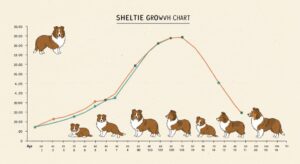Are you the proud parent of a Sheltie puppy? Understanding how your Shetland Sheepdog grows can help you track their development, maintain their health, and enjoy every stage of their life. In this guide, we’ll explore a complete Sheltie growth chart, what to expect at each life stage, and tips to ensure your pup is growing up strong and happy.
Table of Contents
Overview of Sheltie Growth

Shetland Sheepdogs, affectionately known as Shelties, are a small to medium-sized herding breed with charming personalities and beautiful double coats. On average, adult Shelties weigh between 15 to 25 pounds and stand about 13 to 16 inches tall at the shoulder. Like many dogs, their most rapid growth occurs in the first year of life, but each puppy may develop at its own pace.
Sheltie Growth Chart by Age
Use the Sheltie growth chart below as a general guideline to estimate your puppy’s development. Keep in mind that genetics, nutrition, and overall health can influence growth rates.
| Age |
Weight Range (lbs) |
Height Range (inches) |
| 8 Weeks |
3 – 5 lbs |
6 – 8 inches |
| 3 Months |
6 – 10 lbs |
8 – 10 inches |
| 4 Months |
8 – 12 lbs |
9 – 11 inches |
| 6 Months |
10 – 16 lbs |
10 – 13 inches |
| 9 Months |
12 – 20 lbs |
11 – 15 inches |
| 12 Months |
15 – 25 lbs |
13 – 16 inches |
| 18 Months |
15 – 25 lbs (fully grown) |
13 – 16 inches (fully grown) |
Most Shelties reach their full height by 12 months but may continue to fill out and gain muscle until 18 months of age.
Factors Affecting Sheltie Growth
Just like people, no two Shelties grow exactly the same. Several factors can affect the growth of your Sheltie puppy:
- Genetics: Your Sheltie’s size is largely determined by its parents. Smaller or larger parents often produce puppies of similar sizes.
- Nutrition: A balanced diet rich in protein, vitamins, and minerals is vital for healthy development.
- Exercise: Regular activity helps build muscle and maintain a healthy weight, but excessive activity in very young pups can hinder joint development.
- Health Conditions: Illness, parasites, or growth-related disorders can affect your Sheltie’s size and development rate.
When to Be Concerned About Growth
While the growth chart gives a helpful benchmark, you might wonder what’s normal and what’s not. Consider speaking with your vet if you notice:
- Your puppy stops gaining weight for more than two weeks.
- There’s an unusual swelling of the joints or limping.
- Your Sheltie is significantly under or overweight for their age.
- They lack energy or show signs of digestive problems.
Early intervention can help rule out or manage conditions like malnutrition, thyroid disorders, or skeletal issues.
Nutrition and Exercise Tips for Healthy Growth
Proper nutrition and moderate exercise are key for growing Shelties. Here are some tips to keep your pup in peak condition:
- Feed high-quality puppy food: Choose a breed-appropriate formula with real meat as the first ingredient and no fillers.
- Follow feeding guidelines: Use portion recommendations based on your puppy’s age and weight, adjusting as needed.
- Monitor body condition: You should be able to feel your puppy’s ribs but not see them prominently.
- Encourage play, not overexertion: Short walks, playtime, and mentally stimulating activities are better than intense physical exercise.
- Provide plenty of fresh water: Hydration supports digestion, muscle function, and overall health.
Final Thoughts: Enjoy the Journey!
Watching your Sheltie grow is one of the most rewarding parts of dog ownership. With the help of this Sheltie growth chart, you’ll be better prepared to track your puppy’s development and ensure they’re growing into a happy, healthy adult. While each Sheltie is unique, keeping an eye on weight, height, and general health will set them up for a lifetime of love and companionship.
If you’re ever unsure about your Sheltie’s growth or health, don’t hesitate to contact your veterinarian. They can provide personalized insights and make sure your furry friend is thriving every step of the way.
 Shetland Sheepdogs, affectionately known as Shelties, are a small to medium-sized herding breed with charming personalities and beautiful double coats. On average, adult Shelties weigh between 15 to 25 pounds and stand about 13 to 16 inches tall at the shoulder. Like many dogs, their most rapid growth occurs in the first year of life, but each puppy may develop at its own pace.
Shetland Sheepdogs, affectionately known as Shelties, are a small to medium-sized herding breed with charming personalities and beautiful double coats. On average, adult Shelties weigh between 15 to 25 pounds and stand about 13 to 16 inches tall at the shoulder. Like many dogs, their most rapid growth occurs in the first year of life, but each puppy may develop at its own pace.